Sergio Ruiz, who earned the honour of becoming Charlotte FC’s first-ever signing, now has a teammate, joking on Twitter that, “I will finally be able to train with someone.”
That someone is FIFA Puskas 2018 nominee Riley McGree, the 21-year-old Australian moving from Adelaide United. You’ll remember his incredible scorpion kick competed with Cristiano Ronaldo’s iconic bicycle kick for Real Madrid, as well as the brilliant individual goal from Liverpool’s Mohamed Salah that won the prize.
Since Charlotte FC’s inaugural season was pushed back to February of 2022, McGree was subsequently shipped off to Birmingham City of the EFL.
In this tactical analysis, we’ll take a thorough look at which qualities McGree will bring to the Charlotte midfield. Our scout report starts with an analysis of his usage at Adelaide, followed by technical and tactical evaluations. Finally, since his new parent club is yet to take to the pitch, this analysis will briefly consider the tactical trajectory of sporting director Zoran Krneta’s roster and scouting director Thomas Schaling’s scouting considerations.
How was McGree used at Adelaide United?
In Australia’s 11 team A-League, Adelaide United finished seventh, narrowly missing out on the Finals Series, essentially the A-League’s playoffs, by one point. Despite missing the playoffs and finishing with a -5 goal differential, goal scoring wasn’t the problem. Of Adelaide’s 44 goals (4th in the league), McGree paced the team with 10 goals and tied Ben Halloran’s mark of five assists.
Adelaide United’s tactical setup was typically a 4-3-3 or a close variant. Within that system, McGree was utilised as a centre-attacking midfielder, or a #10 for short.
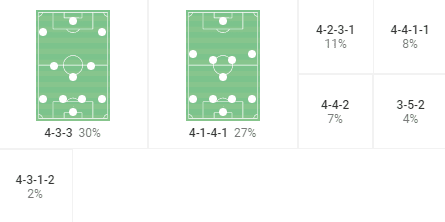
A creative player how excels in progression through the dribble and his work close to goal, his heat map lights up both at midfield and deep in the half spaces. As Adelaide progressed into the final third, it was common for McGree to operate in the half spaces, especially on the right.
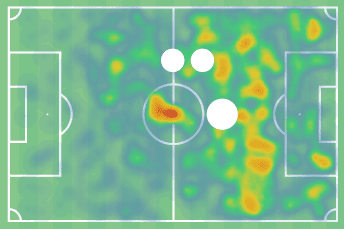
As a left-footed player, receiving the in right half space allows McGree to more easily orient his body towards goal, all while keeping the ball on his preferred left foot. Don’t take that to mean he’s a one-footed player. Film analysis shows that he’s capable of sending dangerous deliveries into the box with his right foot too.
Filling that creative #10 role, McGree was often used as a high target during the early attacking phases. Though he’s capable of dropping into the midfield and dictating play from deep, Adelaide United pushed him higher up the pitch, often asking him to play between the opposition’s defensive and midfield lines.
The image below gives an idea of his usage. Rather than a high volume, tempo dictating passer, McGree was utilised higher up the pitch, directing the move on goal.
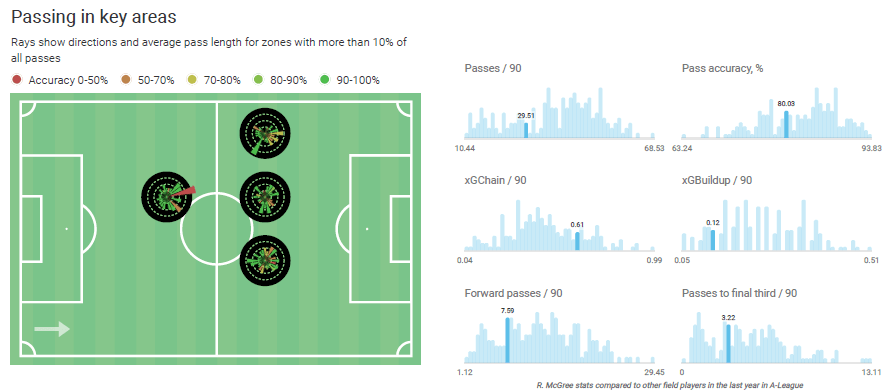
His xGBuildup/90, which is best suited for evaluating the passing contributions of deep playmakers, is very low, but his xGChain/90, which is an attacking metric that measures the value of passes leading up to a shot, is high. Analysis of McGree’s passing statistics shows he’s best suited as a classic #10. Match footage testifies to that claim as McGree is much more explosive when his defensive responsibilities are limited to the high press and counterpressing.
Technical ability
Named the A-League’s “Young Footballer of the Year” for the 2019-20 season, McGree became one of the most dangerous players in the league last campaign. Rating in the top 10 in both goals (10 total) and assists (five total), the Australian youth international was ever-present in Adelaide United’s goal-bound attacking moves. At the root of his attacking outburst was a strong technical skillset in tight spaces.
As shown in the heat map in the previous section, McGree often receives the ball just beyond the opposition’s box. It’s common to see him receive between two lines of players, then run at the player in front of him. The objective isn’t necessarily to beat the defender on the dribble. Rather, he wants to pull a defender out of the opposition’s defensive structure and pin the defender, then combine with a teammate.
However, if the opposition doesn’t give the pressure defender coverage, McGree is more than comfortable diversifying his approach, engaging in a 1v1 duel before determining his next course of action. That’s exactly what’s happening in the image below. With the pressure defender isolated, McGree made a quick cut to his weaker right foot, surprising the defender.
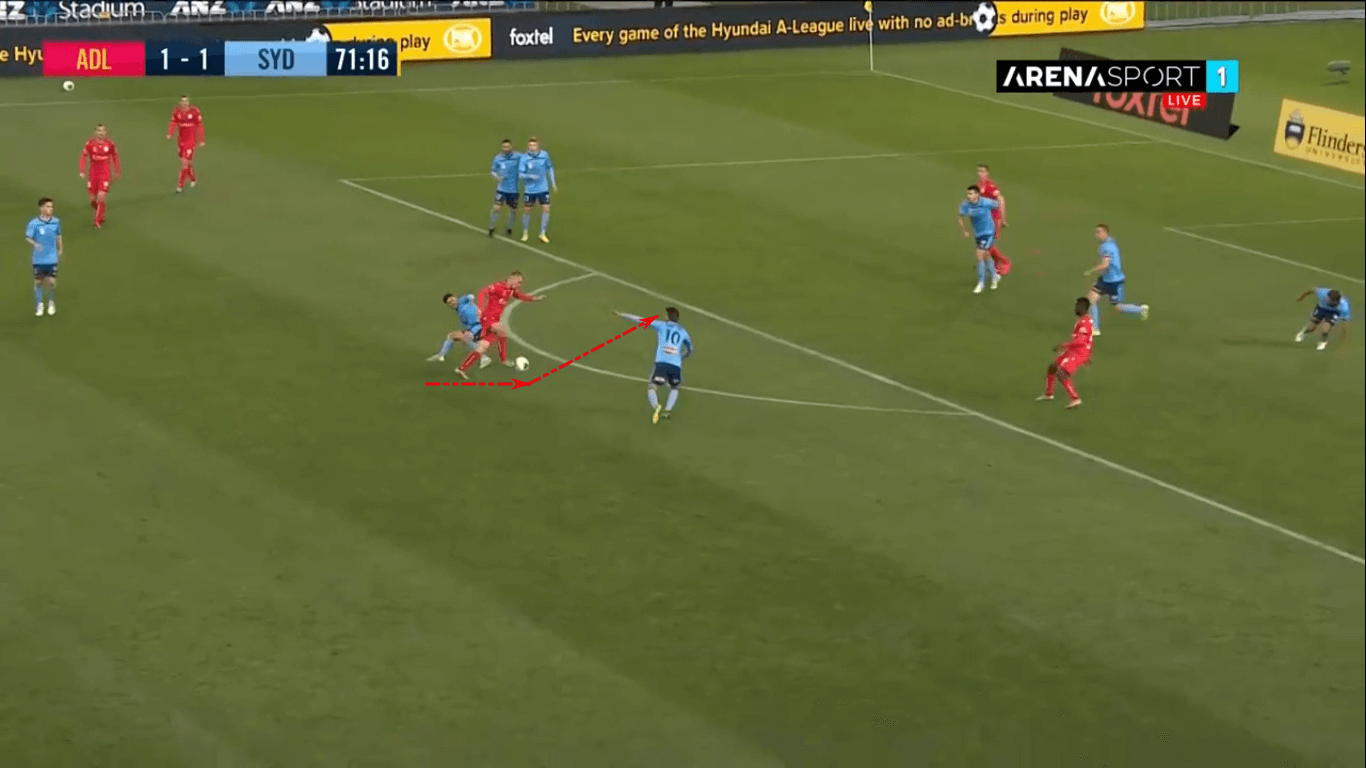
After beating the first defender, he cut back onto his preferred left foot. Without a realistic passing option, the young Aussie somehow managed to send his shot through the traffic, forcing a save from Sydney FC’s Andrew Redmayne.
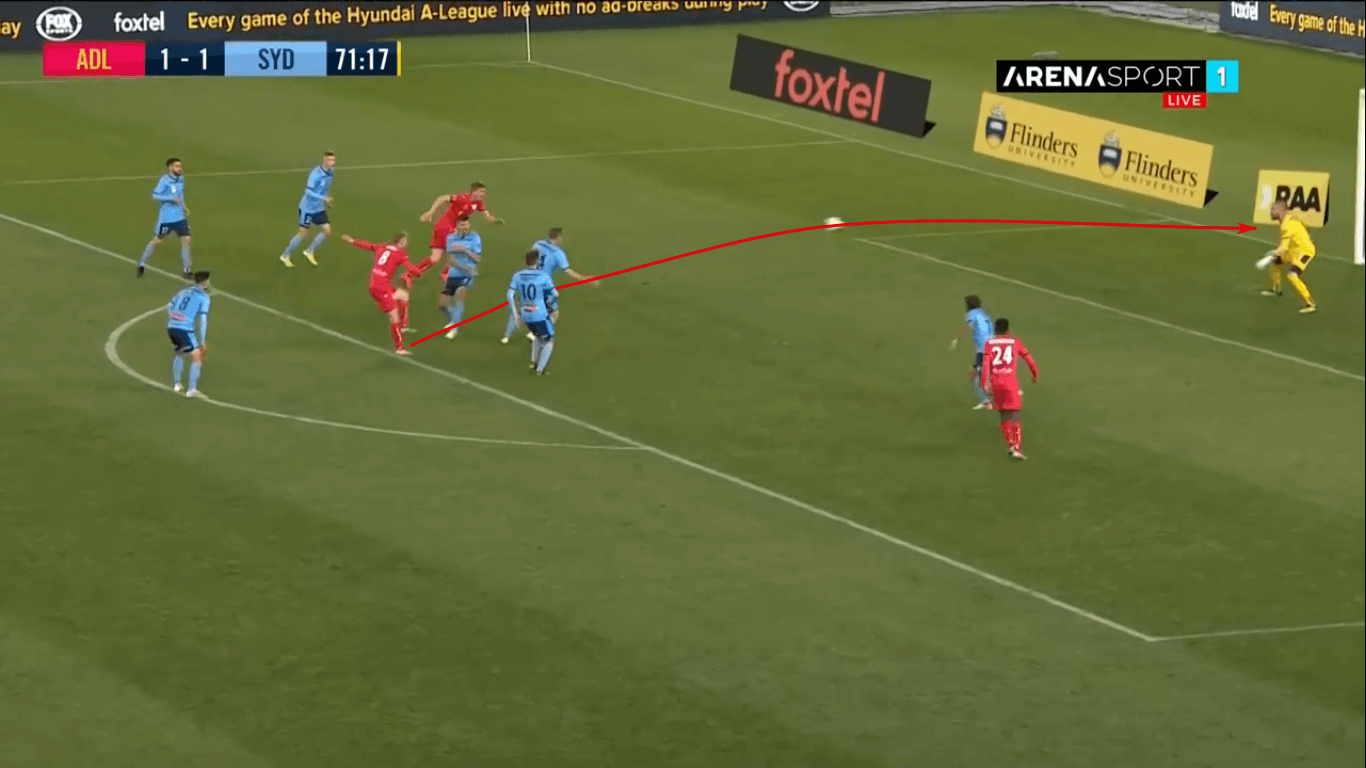
Speaking of shooting, McGree ranked 9th in the A-League with 71 shots (3.01 P90) with a strong 0.12 xG per shot, indicating that he will generally shoot from higher-quality shooting positions. While he certainly moves well in the box (more on that in a moment), he is a player with some range.
In a March 7th match against Western United FC, McGree grabbed his side’s only goal with a blast from approximately 22 yards out. While you could make the case the keeper should have done better at his near post, the power and dip on the shot excuses Filip Kurto of any wrongdoing.
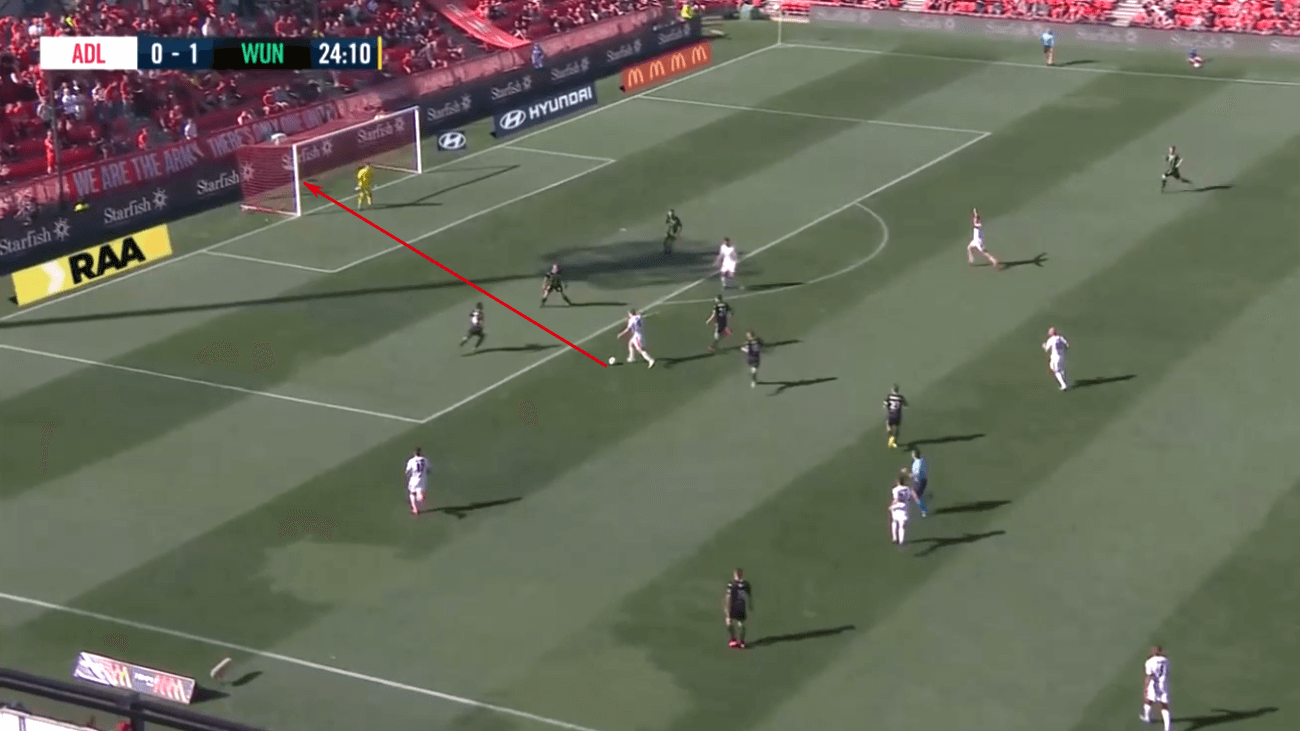
McGree’s stats show a player who was primarily utilised as a true central attacking midfielder, positioned high up the pitch to lead the move to goal. While he rated behind most of the A-League’s #10s in forward passes (7.59), smart passes (0.76), passes (29.51) and pass percentage (80%), his role required less contribution in those areas. Much like Manchester United’s Bruno Fernandes, the lower passing percentage is largely predicated on the creative, audacious player that McGree is. Rather than playing safe passes, he’s continuously looking to break the opposition’s back and get to goal. That quality is manifest in his goal contributions, both real and expected.
If there’s an aspect of his technique that needs work, it’s in the way he goes about his tackles. Yes, defensive technique is very different from attacking, ball-related technique, but it’s a necessity nonetheless.
Standing at 5’10” and 159 pounds, McGree is decent size, but he doesn’t use his physicality well in defensive duels. When he engages in tackles, he’ll typically rely on the block tackle, extending one foot in the direction of the attacker and hoping for the best. Though centre-backs and defensive midfielders aren’t the most capable dribblers, the approach is simple enough to beat.
The image below shows a scenario against Melbourne Victory. Dropping deep to help in defence, McGree decided to engage the attacker in an all-or-nothing duel even though the Adelaide backline wasn’t in position to offer coverage. If you look closely, you can see his right leg extended towards the ball with his centre of gravity behind his plant foot, leaving McGree off balance and unable to adapt to his opponent’s move.
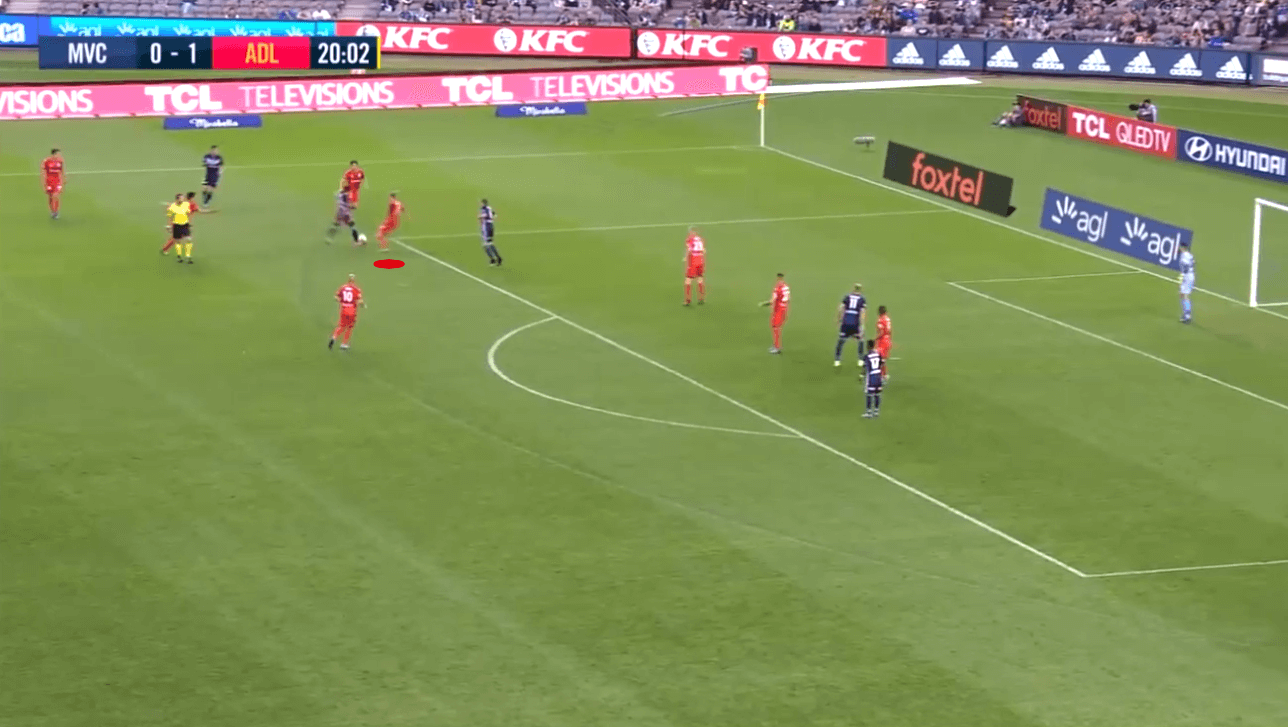
A similar situation occurred against Western Sydney Wanderers FC. Even though two teammates funnelled the opponent into him, McGree gambled on the potential negative pass, leaving him ill-equipped to make the tackle. This time, it’s the left foot far in front while the centre of gravity remains behind his plant foot. The big tactical takeaway in this sequence is that allowing the negative pass is safer than allowing the opponent to break a line on the dribble.
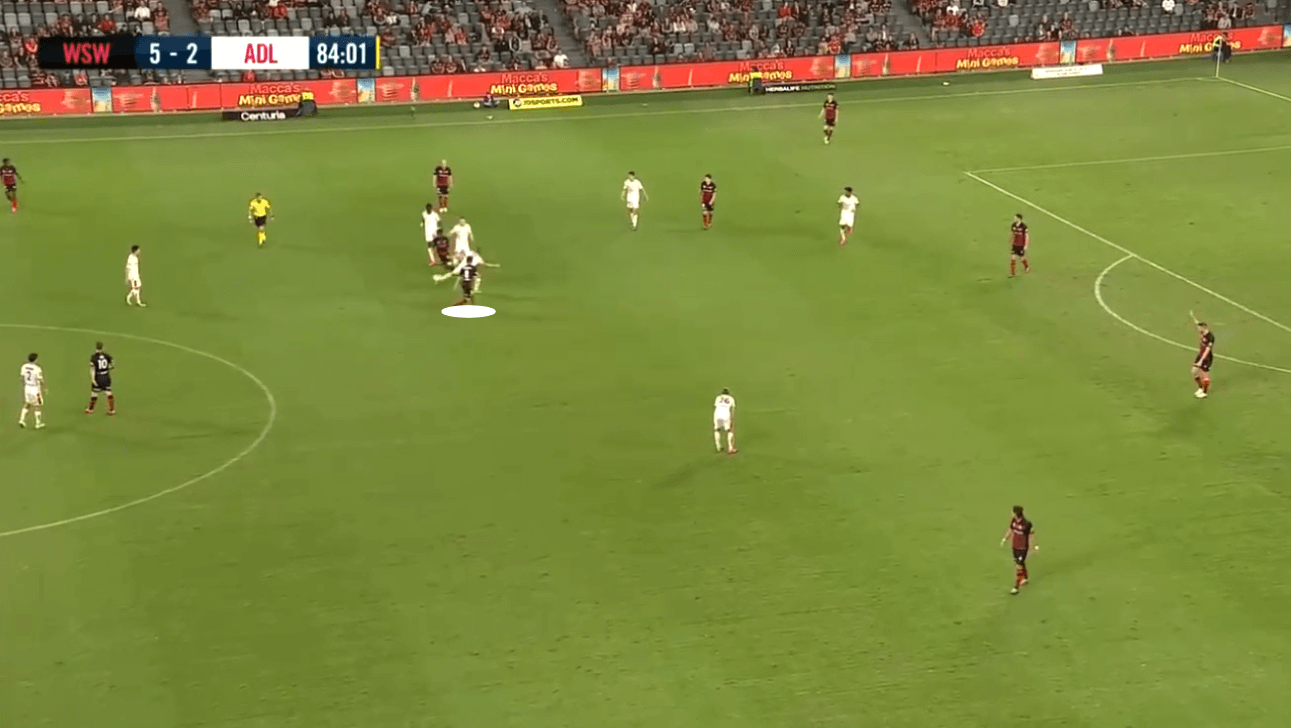
In our final image, McGree isn’t using the block tackle, but some recurring defensive technical principles are still lacking. Playing against his former team, Newcastle Jets, McGree was dutifully pressing the opponent as they tried to play out of the back. The centre-back is using his size advantage well, but look at where McGree is making contact. Rather than making contact near the hips, negatively impacting his opponent’s balance, McGree’s contact is high on the shoulder blades. The opponent was able to ride out the contact and release his pass.
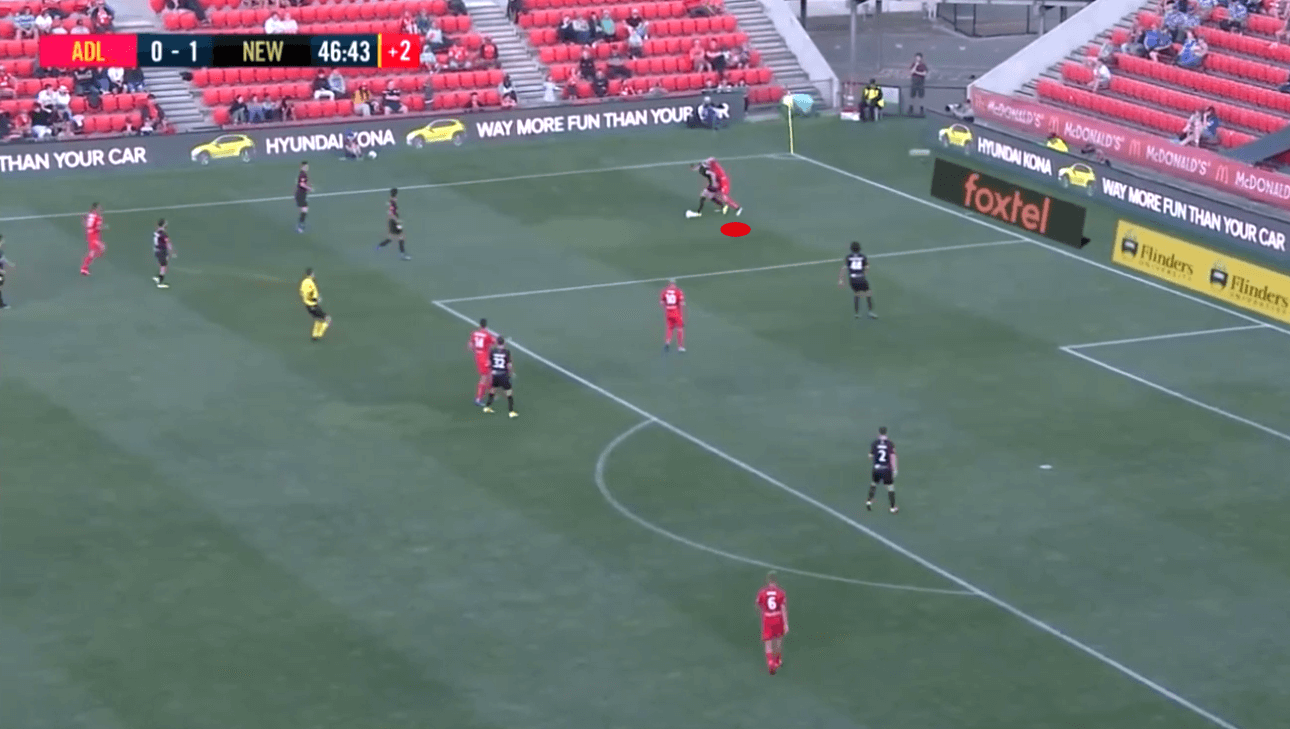
The main defensive technical qualities that need attention are how he leads into his tackles, applying contact at the opponent’s hips to impact balance and using more physicality in the tackle. If he can go into each tackle as a battle for balance, he should make quick improvements in this area. Ultimately, initiating contact with his hands or forearms rather than his feet should allow him to approach the opponent from a position of strength. If he can instil that habit while also showing patience to force the opponent into the first move, his defensive technique become a source of strength since he is a quick player.
Tactical acumen
Among A-League #10s, McGree rated in the 90th percentile or better in non-penalty xG (0.38), xG per 90 (0.37), shots per 90 (3.01) and touches in the box per 90 (4.24). As a true #10, he was a livewire in and near the box. Assuming that Charlotte FC and Birmingham City use him in a similar fashion, McGree’s scanning and ability locate dangerous pockets of space could be a real game-changer, especially if he has willing runners in front of him.
Two of the qualities you love to see in a true #10 are receiving the ball in a dangerous part of the pitch and a direct mentality. Beneath those two qualities are tactical intelligence and ruthlessness. McGree has them in abundance.
Despite his lack of physicality on defence, he’s shown an excellent ability to receive a pass near the top of the box while shielding an opponent from the ball. He’s doing that below, holding off the opponent on his right while receiving with his left.
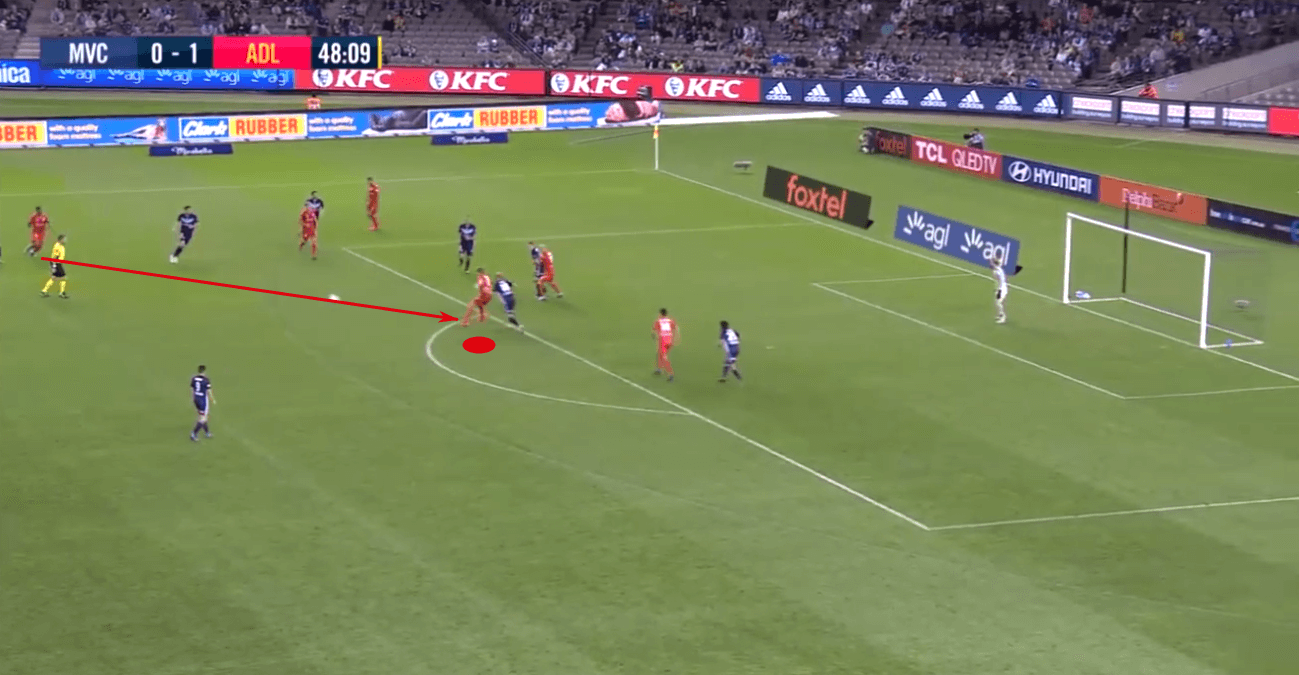
The thing that really stands out in this sequence is his added deception. Since he’s holding off the opponent with his right arm and receiving with his left foot, it’s natural to assume he’d pivot towards his left, sensing the open space. However, his move brings the defender back towards their left, freeing up McGree to make a powerful turn to his right, placing the ball on his preferred left foot. He then dinks a pass over the opponent’s outstretched foot, sending his teammate in on goal.
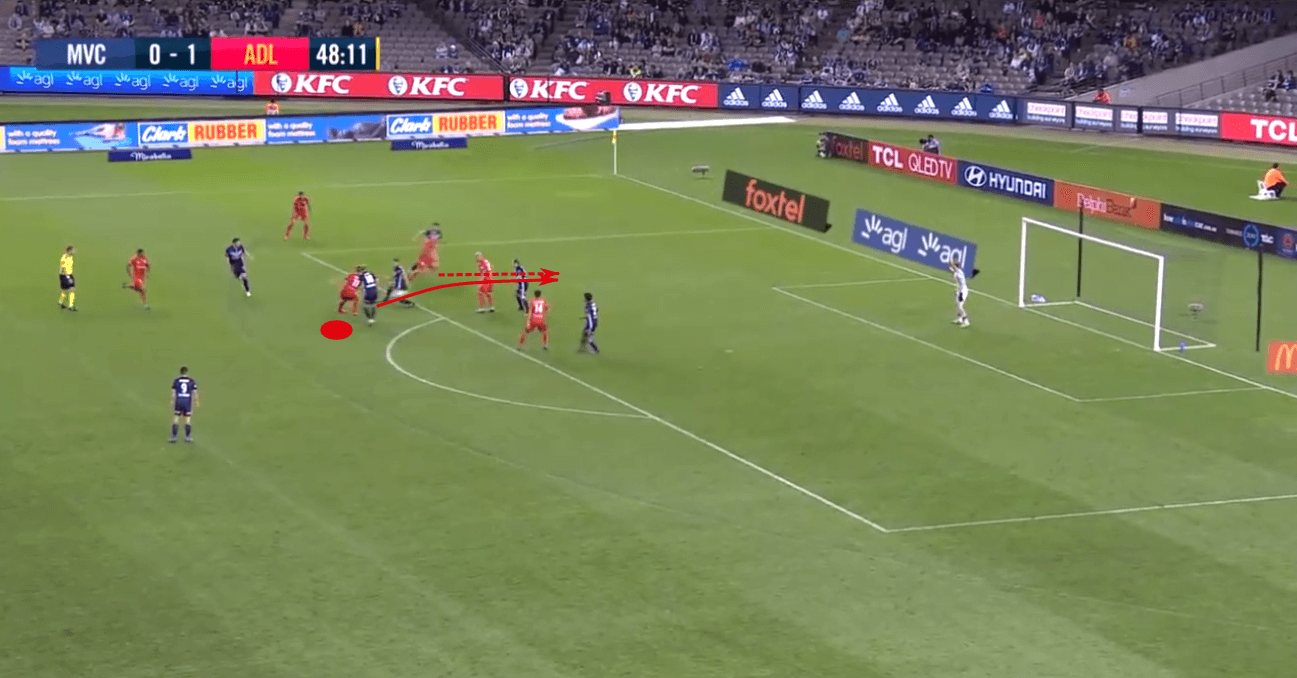
McGree’s positional awareness in and near the box greatly benefits his teammates, rewarding active runners with nicely slotted passes behind the line. As Adelaide United attacked in the final third, it was common to see the Australian youth international operate more freely. That tactical freedom allowed him to target pockets of space in and near the box so that he could exercise his technical qualities and intelligent approach to the team’s tactics.
In the image below, his tactical intelligence is once again on display. Likely my favourite sequence from this scout report, we have Adelaide United darting forward on the counterattack. The broken line shows McGree’s running path while the triangle highlight’s where he’s looking.
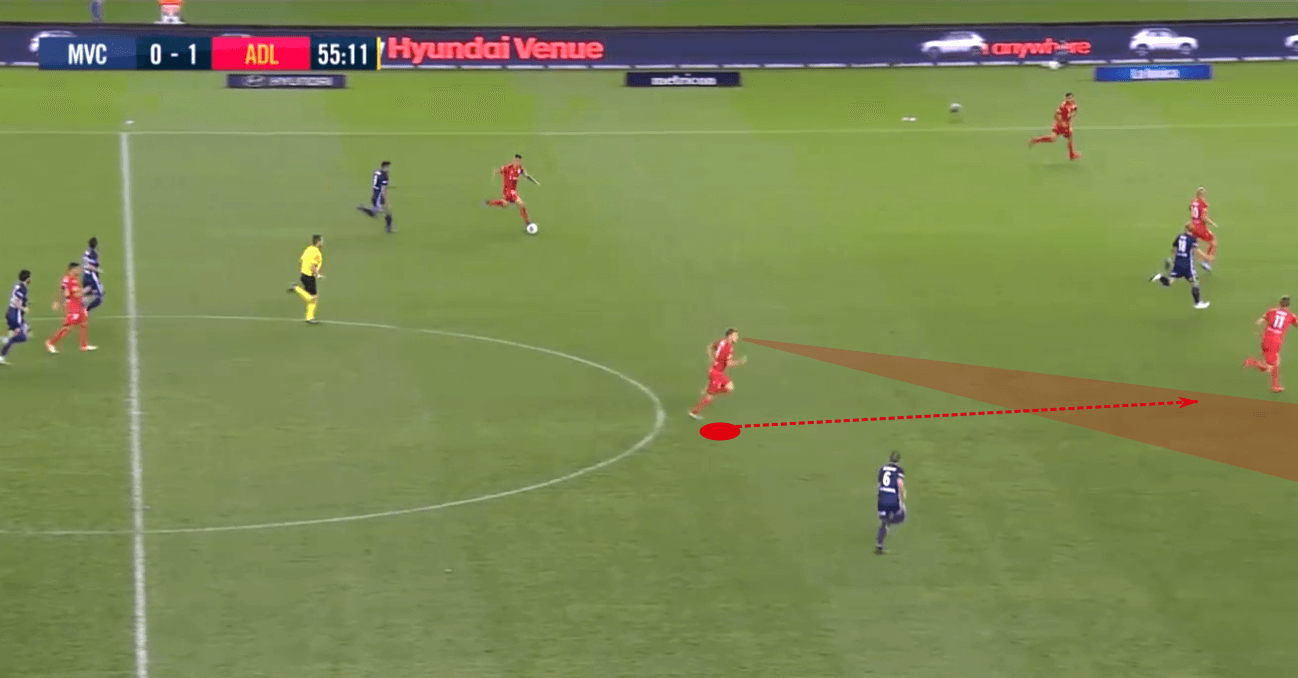
After a number of scans to his left and right, McGree sees the pass headed in his direction. There’s a nice running lane into the heart of the box. Seeing Adelaide’s top goal-scorer running into that lane with the ball en route to him is enough to pinch the defenders centrally. Seeing that he’s earned their commitment, McGree cleverly dummies the pass. The brilliant move sends his teammate, George Blackwood, at the back post. The shot smashes against the post, but it’s the bit of individual brilliance from McGree that stands out.
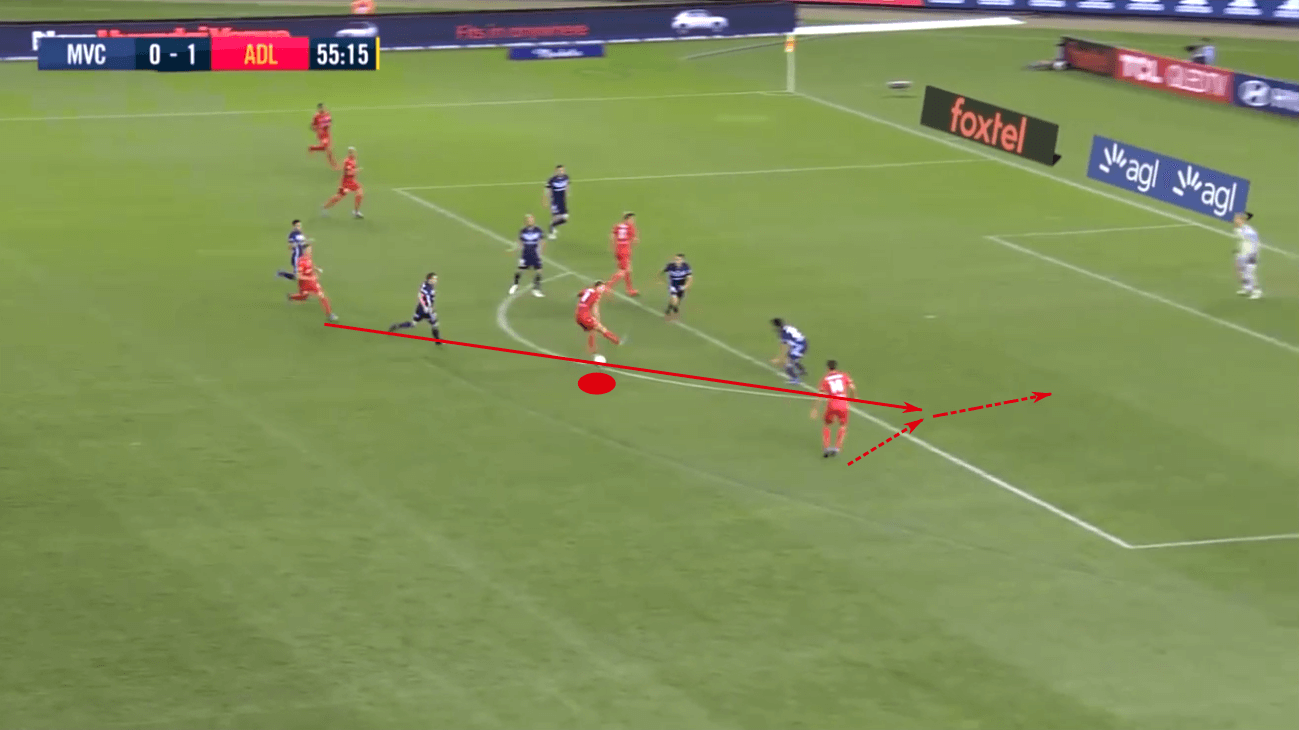
In addition to his creativity and intelligent positioning just outside the box, the former Club Brugge player is also a handful in the box. Much like Barcelona’s Messi, McGree’s runs into the box are typically uncontested and to the penalty spot. To make that run effectively, the attack must have an excellent sense of timing to make these late runs into the box. By making the runs at the last possible moment, McGree is often untracked into the box and rarely contested on his shots for the centre of the box.
In the situation below against Brisbane Roar FC, McGree grabbed the late winner with an uncontested shot from the middle of the box. As James Troisi turned the corner on his defender, the Brisbane defenders scrambled to block his lane to goal, as well as the most immediate passing options. That allowed McGree to calmly pick his spot, offering Troisi the exact passing angle needed.
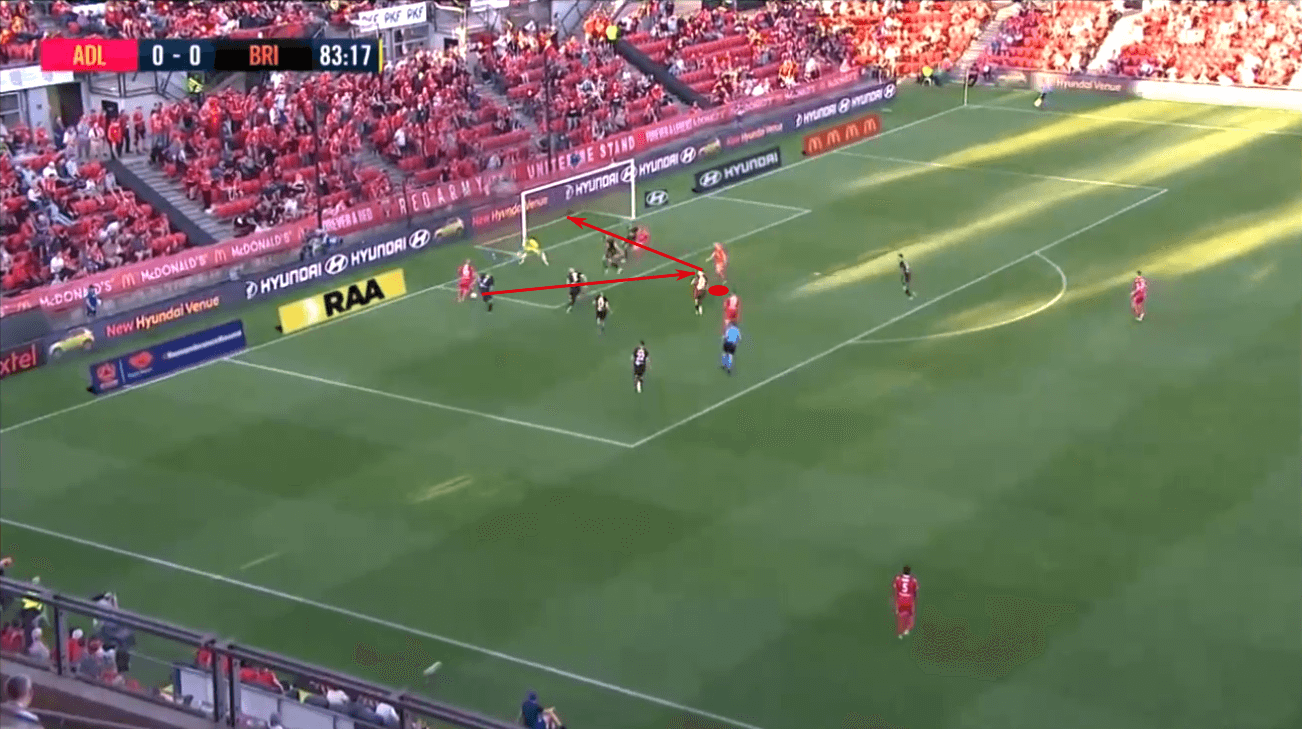
Certainly at Charlotte FC, you can expect to see McGree operating in a similar manner. Although it’s a team of two players at the moment, the other, Ruiz, is more of a box-to-box type player, but we’ll go into Charlotte FC’s midfield in a moment.
Our last consideration in the tactics section is his defensive work. As mentioned, his tackling is a work in progress, though he still rates in the top half of A-League #10s in defensive duels won percentage.
Where you’ll really see McGree make a difference is in his recoveries in the final third and counterpressing recoveries. In the first category, he finished 3rd in the A-League last season with 2.16 final third recoveries per 90. Perhaps more importantly for the side Krneta and Schaling are building is the counterpressing recoveries. With 3.14 per 90, making him 4th in the category, McGree is very active in the counterpress, willing to pressure opponents as soon as possession is lost.
How Charlotte FC and Birmingham City plan to use him remains to be seen. From a defensive standpoint, he’s a willing counterpresser, but he’s also very attentive to the team’s defensive tactics. Adelaide United typically asked him to take away the opponent’s defensive midfielder in the build-up, a task he performed at a reliably high level as his scanning ability allowed him to track his mark well, as seen below with the red circle.
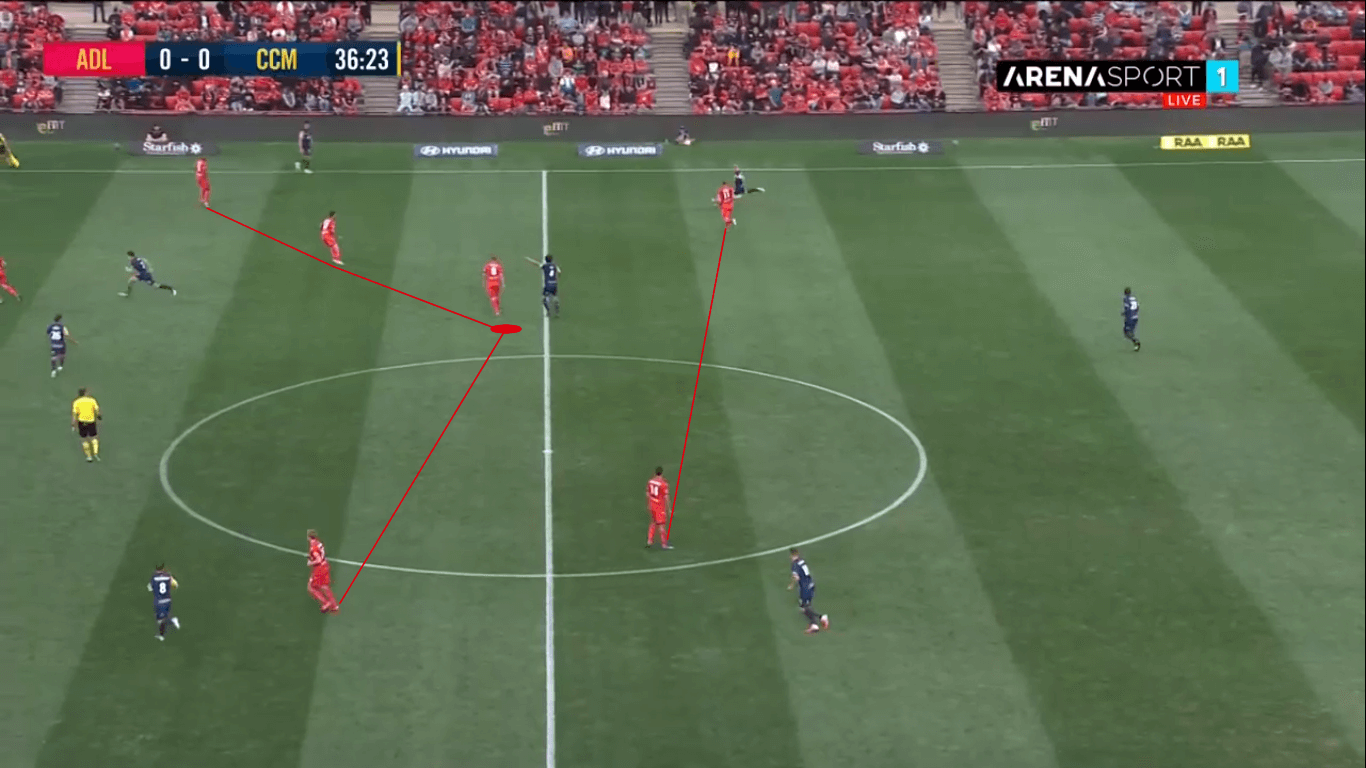
McGree will primarily bring his attacking qualities to Charlotte and Birmingham, but it is worth noting that he’s a reliable defender with high press and counterpressing instincts. That’s perhaps where he makes the biggest departure from the traditional #10. Once a pure, all-out attacker, the modern #10, few as they are, must contribute to the side’s defensive tactics or ride the pine, much like we’re seeing at Arsenal.
The emerging picture of Charlotte FC’s midfield
If you’ve read the analysis piece on Sergio Ruiz, you know Charlotte has the first two pieces of their midfield (and team). With Ruiz operating as a box-to-box midfielder, McGree will in all likelihood take on a role similar to the one he played with Adelaide. We still don’t know who that third midfielder is, or even if the midfield will consist of three central players, but my guess is that we’ll see a defensive midfielder with strong defensive qualities, possibly with an ability to set the tempo as a deep-lying playmaker, enter the fray.
Until then, we can only speculate on the next move and the likely philosophy and tactics Charlotte FC will espouse. Early indicators point to a high pressing team with a very heavy emphasis on counterpressing. With Ruiz offering two-way stability and McGree bringing his high presence into the fold, you can see the front office targeting a false nine type player, much like Roberto Firmino. That would improve the link-up with McGree and free Charlotte FC to bring in active wingers who will offer runs behind the backline.
The wingers will in turn determine the type of outside-backs necessary for the club’s tactics. If one or both wide forwards/midfielders are inverted or more prone to starting in the half spaces, you’ll then see more attack-oriented outside-backs.
At the very least, we can at least speculate based on the two players on the roster. With McGree, look for him to continue offering that high, creative outlet. When the side losses the ball, he will pressure the opponents.
One aspect of his game that deserves a mention is his ability to anticipate and block passes. He really has a knack for picking out the most likely course of the ball and blocking its path. That’s how he set up the goal against Melbourne Victory. With the defender backtracking to win the header, McGree anticipated weak contact. He was correct, collecting the headed ball at his thigh, then dribbling towards goal.
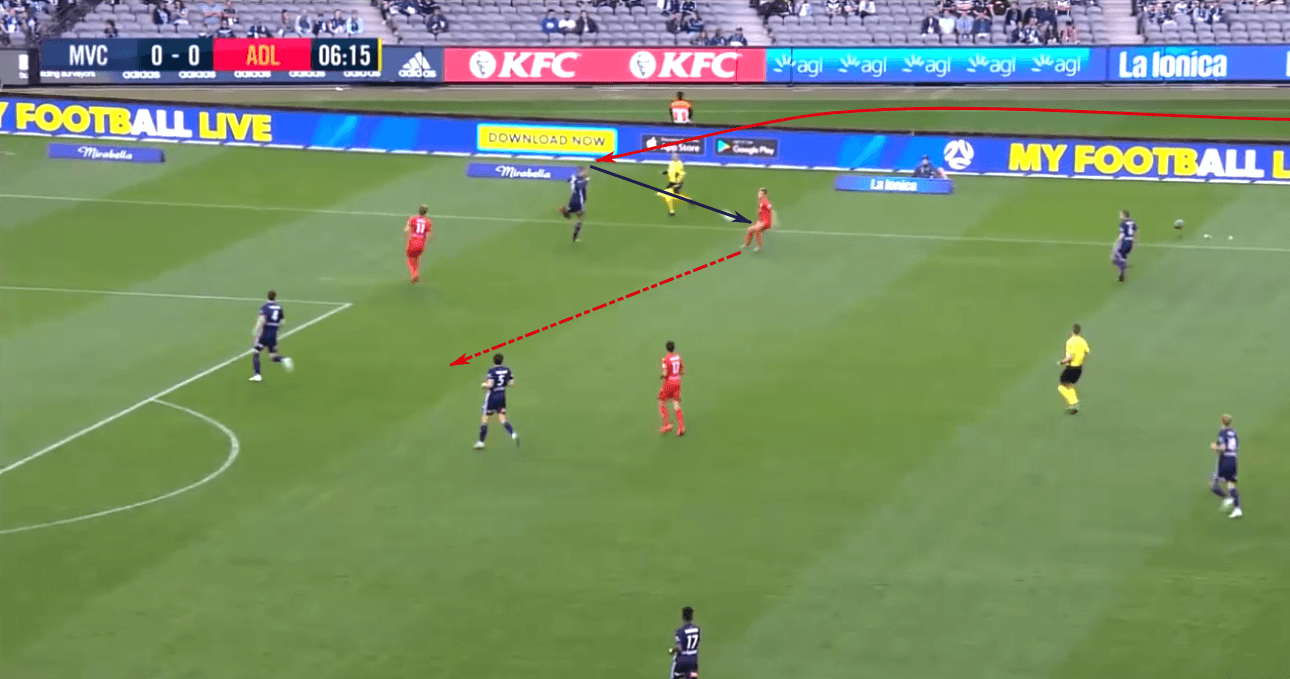
As the defence closed him down, he picked out a nice passing lane to Kristian Fardal Opseth, setting up the opening goal.
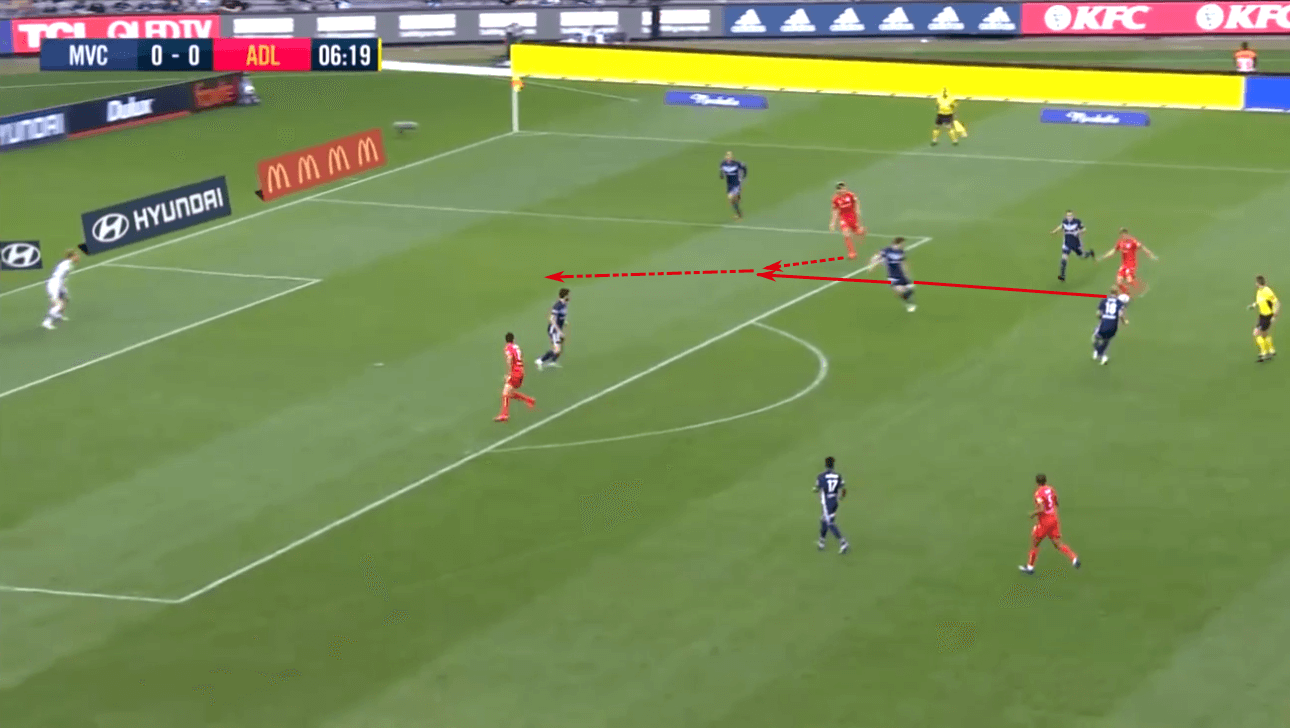
McGree’s defensive qualities, especially his knack for blocking passes, recoveries in the attacking third and counterpressing recoveries have surely played a massive role in this deal.
The other thing you can expect when he gets to Charlotte is that the club will find a centre forward that McGree can play off of. Since the young Australian is such a dynamic goal-scorer and assister, he’s the type of player you bring in to offer that scoring presence from midfield.
You’ll see him work off the centre-forward much like he is the example below. Ben Halloran has rotated into the #9 role and positioned in the middle of a Sydney FC square. Since he’s positioned behind the midfielders, the defenders are aware that they’ll likely have to step to him. That brings an additional problem. With Halloran positioned between the two centre-backs, Ryan McGowan, on the right, can’t step immediately to McGree. That creates a pocket of space for the Adelaide United attacking midfielder.
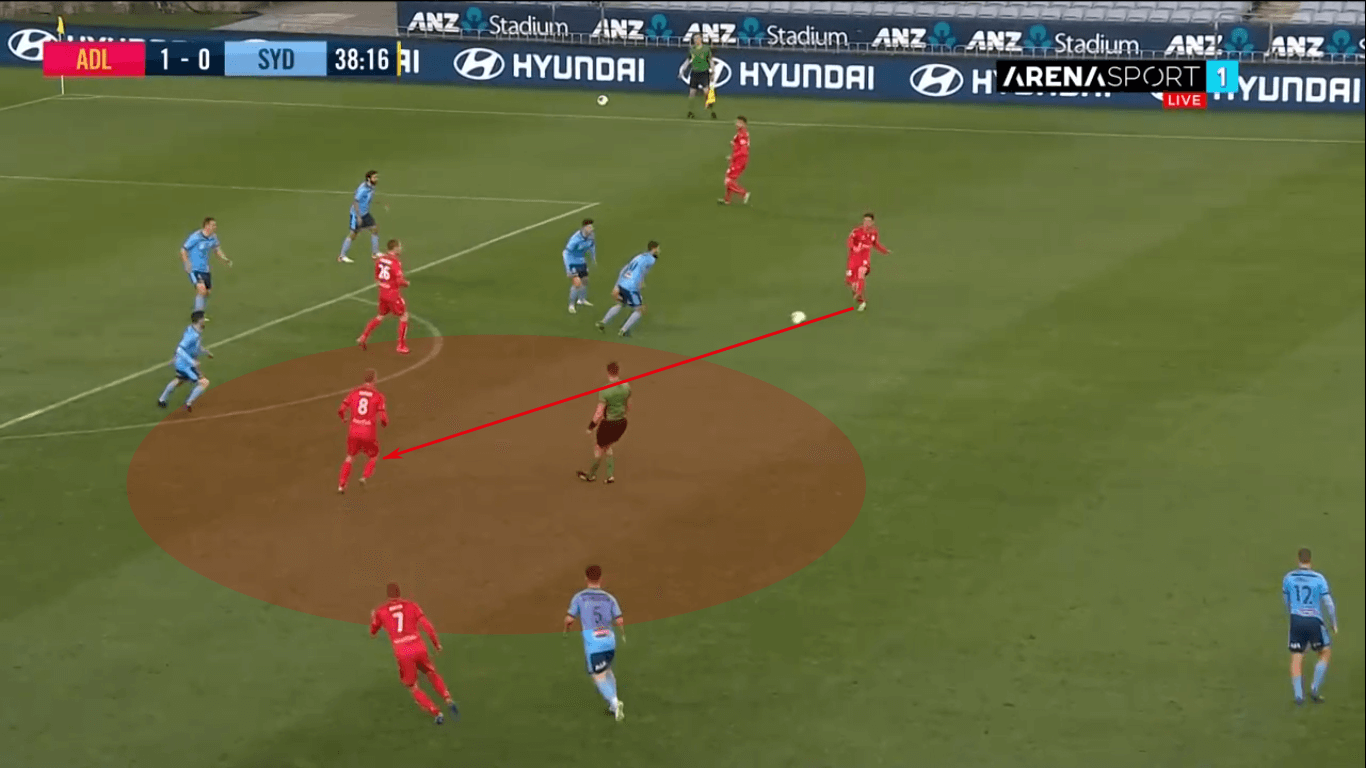
Once he receives the pass, he then has time to play to his left. With the defender lunging for the pass, he’s no longer able to run with McGree, who’s looking for the return ball.
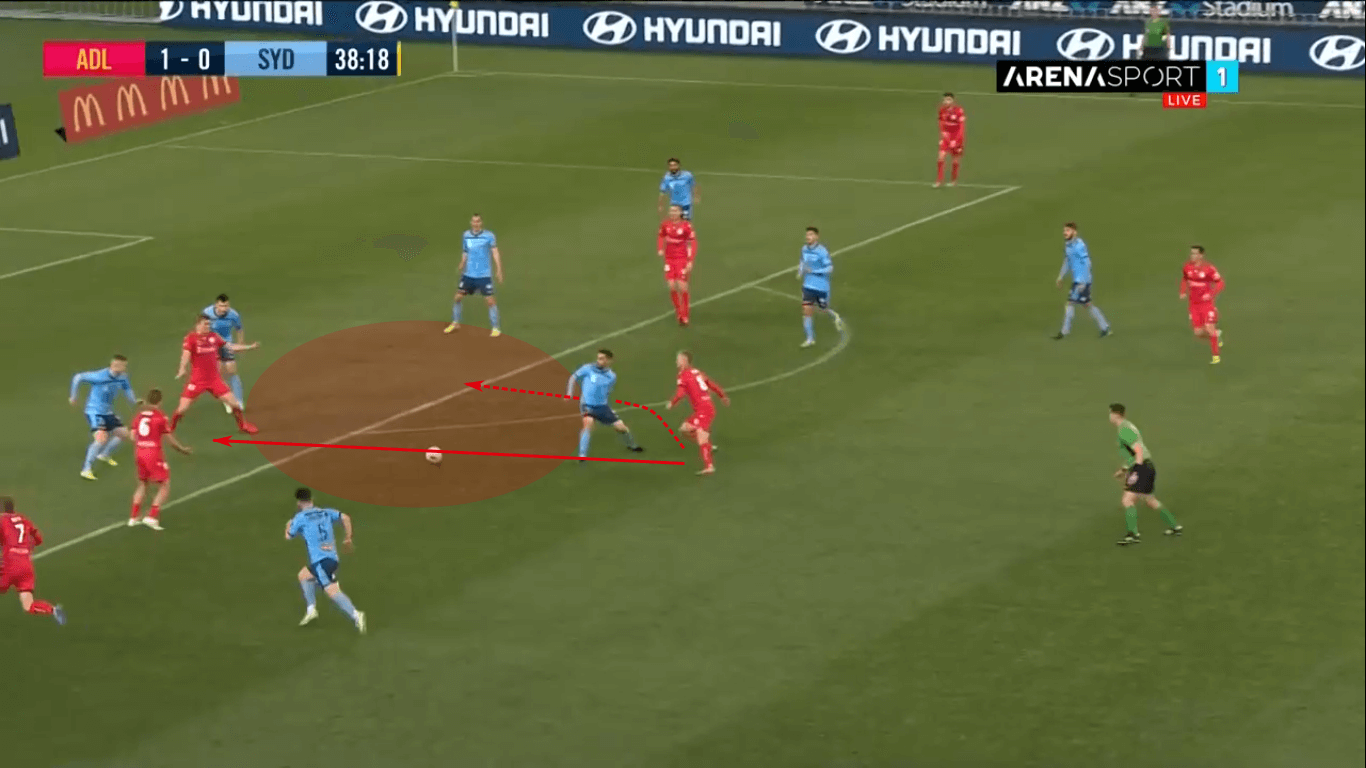
McGree’s proclivity for receiving between the lines before combining in Zone 14 and running into the box will be very difficult to defend against in the MLS. Look for Charlotte FC to sign a centre-forward who compliments his style.
As for Ruiz, this signing will likely require a greater responsibility in the team’s rest defence (their shape while in possession) to restrict the success of the opposition’s counterattack. If there’s a running theme with these signings, both are intelligent players. Look for Ruiz to take a more opportunistic approach in the attack. The roles of the outside-backs, and the defensive qualities of the remaining midfielder, will offer more insight.
Conclusion
With a second signing on the books, Charlotte FC is taking shape in advance of their inaugural season. Krneta and Schaling have some time to identify additional targets, but this is a nice start to the roster build, especially since European clubs had a rumoured interest in McGree.
The fee is undisclosed at the moment, but it’s safe to say Charlotte have signed a player who’s largely regarded as an important figure in the Australian national team’s future. With his significant goal contributions, intelligent use of space and willingness to engage defensively, the club appears to be living up to owner David Tepper’s go big or go home philosophy.





Comments